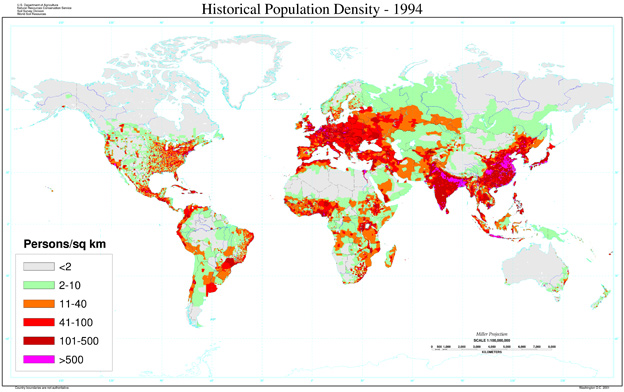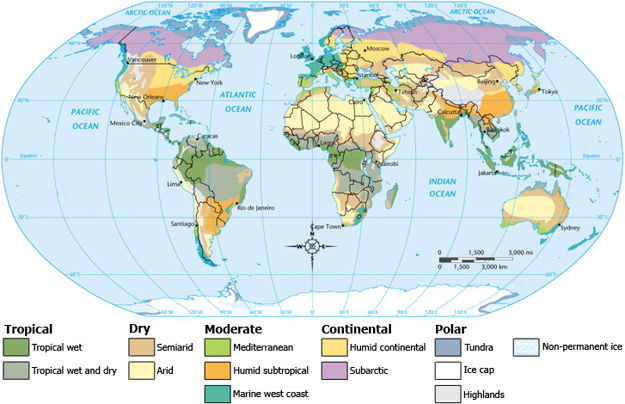


Answer the following question by comparing the two maps above.
Which of the five types of climate zones has the highest population density?
A. Tropical
Incorrect. There are large areas of this climate type, but they are not all densely populated.
B. Moderate
Correct! This climate type is not too hot and not too cold; many people choose to live there.
C. Dry
Incorrect. There are large areas of this climate type, but they are not densely populated.
D. Polar
Incorrect. Although there are many areas in this climate type, they all have very low populations.


Answer the following question by comparing the two maps above.
Which of the following climate zones is the least populated?
A. Mediterranean
Incorrect. The few areas with this climate are very densely populated.
B. Tropical Wet
Incorrect. The areas with this climate have low population density, but not the lowest.
C. Arid
Incorrect. Although these climates are harsh, some areas have higher population densities.
D. Tundra
Correct! The areas of this climate zone are at extreme Northern regions with little to no population.


Answer the following question by comparing the two maps above.
Which of the following climate zone and population combinations would be most concerned with the lack of water resources?
A. Large densely populated city in a tropical wet climate zone
Incorrect. Because the tropical wet climate zone indicates plenty of rain water to aid crops, a warmer climate so as not to freeze water, and moist climate so as not to allow rapid evaporation.
B. A small village in a humid subtropical climate zone
Incorrect. Because the population is small and a humid subtropical zone should suggest warm and moist climate.
C. A medium size city in a Mediterranean climate zone
Incorrect. Because the Mediterranean climate zones are all near coastline, which indicates access to plentiful water; also the climate is moderate suggesting it is not extremely dry.
D. A small farming community in an arid climate zone
Correct! Although the community is small it will require a lot of water for its primary activity, farming. In an arid zone, rain is not plentiful, so water for crops can be difficult to find.


Answer the following question by comparing the two maps above.
Which of the following climate zone and population combinations would be most concerned about the lack of oil (non–renewable) resources?
A. A small farming community in an arid climate zone
Incorrect. Because they are a small community (less densely populated) and although they may need oil products for farm equipment, machinery and vehicles, the amount would not be the largest need.
B. A large farming community in a tropical wet zone
Incorrect. Although they are a more populated community that may need oil products for farm equipment, machinery and vehicles, the amount would not be the largest need.
C. A large city in a subarctic climate zone
Correct! This area needs the most oil products for transporting the largest amount of people and also for heating many buildings, including homes, schools, and businesses.
D. A small city in a Mediterranean climate zone
Incorrect. This area is a less densely populated area with a more moderate climate so they have less need for oil products for transportation, and energy needs.